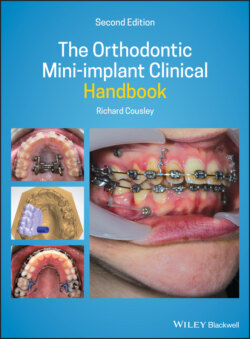Читать книгу The Orthodontic Mini-implant Clinical Handbook - Richard Cousley - Страница 34
2.1 Cortical Bone Thickness and Density
ОглавлениеA combination of clinical, animal and artificial bone studies has demonstrated that the most important patient determinants of primary stability are the density and thickness of the maxillary and mandibular cortical plates. This helps to explain the variations seen in clinical studies of mini‐implant success rates where both anatomical sites and individuals differ in terms of the cortical bone layer's quantity and quality [1]. The key facts to consider are as follows.
Cortical bone thickness (depth) is generally regarded as ranging from 1 to 2 mm (Figure 2.1) and generally increases towards the apical aspect of the alveolus. However, a recent micro‐computed tomography (CT) study of cadavers has shown frequent areas of the maxillary and anterior buccal cortex with less than 1 mm cortex depth (compared to a mean of 1.3 mm palatal alveolar cortex depth and 2 mm or more in the posterior mandible) [2]. In the maxillary alveolus, cortical thickness peaks both mesial and distal to the canines (in the region of the canine eminence) and the first molars, which partly accounts for the frequent use of these sites for anterior and posterior anchorage points, respectively. Notably, the maxillary alveolar cortex is thicker on the palatal than the buccal side, which contributes to the value of palatal alveolar insertions in anterior openbite correction (discussed in Chapter 10), and the highest alveolar values for both jaws occur in mandibular molar sites [2–10].
An increase in either the cortical thickness or density leads to an increase in insertion torque (the resistance to rotational insertion movements) [11–17]. Thickness and density are co‐dependent factors, with density appearing to be the more influential in terms of mini‐implant primary stability [13,14]. The density of the underlying cancellous bone is much less relevant, and hence has less influence on insertion torque [14].Figure 2.1 An axial cone beam CT where the cortical bone is seen as the peripheral dense white line. Notably, the alveolar cortex is much thinner than the mandibular ramus tissue seen posterolateral to the maxillary alveolus in this image. The positions of the two buccal and single palatal roots of the first molar teeth are also evident.
The ideal range of maximum insertion torque appears to be 5–15 Ncm for alveolar sites [12,18–23]. Interestingly, in my experience, the maximum torque for midpalate sites is often higher, peaking between 15 and 20 Ncm in adults. This has been corroborated by a retrospective study of consecutive midpalate insertions (in adolescents and adults) where 90% had 10–25 Ncm final torque readings [24]. Maximum torque occurs during final seating of the mini‐implant and is felt as an increase in resistance on turning a manual screwdriver, such that difficulty in digital rotation typically equates to the top of this torque range. This is clinically valid without it being necessary to measure this in individual patients. In effect, low torque equates to poor primary stability (inadequate cortical support) and excessive torque results in secondary failure because microscopic bone stress leads to microfractures and subclinical ischaemic necrosis around the mini‐implant threads [25]. This manifests clinically as the mini‐implant screwing in with little resistance at the low end of the torque scale, and it being difficult to manually turn the screwdriver at the high end. Such excessive torque, especially in posterior mandibular sites, may be avoided by initial perforation of the cortical plate, as described later.
The most important patient determinants of primary stability are the density and thickness of the cortical plates.
Cortical bone thickness and density are both greater in the mandible than in the maxilla [26]. Our initial instinctive view is that the mandible provides greater primary stability because we regard it as a ‘tougher’ bone. However, mandibular success rates (reported in the literature) are less than those for the maxilla. This is because greater amounts of cortical thickness and density cause excessive insertion torque, which reflects high levels of peri‐implant bone stress. This localised stress results in microscopic bone necrosis around the threads and hence secondary mini‐implant failure [19].
Cancellous bone, which has a similar density in both jaws [26–28], has often been suggested to have little effect on primary stability, except when the cortex is less than 1 mm. This occurs in some patients' maxillary buccal alveolar sites, and the cortical plate provides inadequate stability on its own [2]. In such sites, engagement of the cancellous bone does contribute to mini‐implant stability, as demonstrated in an animal bone study [29]. This may account for the positive association between higher cancellous bone density and mini‐implant success rates in a study of 127 maxillary buccal mini‐implants [30]. Cancellous bone may also influence secondary stability in the long term, by stabilising the mini‐implant body against migration and tipping [15,17,31]. This requires a mini‐implant with a relatively longer body (e.g. 9 mm length) to engage sufficient cancellous bone area.
